Prepping With Pets
(Note: This article includes Amazon affiliate links. While it doesn’t cost you anything, I do make a small commission if you purchase through these links. Your purchases help support this website!)
For many of us, our pets are an important part of our family and we’re willing to take the time and effort to ensure their safety and comfort. Whether they’re a pampered lap-ornament or a working ranch dog, they look to us to ensure their wellbeing and it’s our responsibility to include them in our prepping plans.
The good news is that prepping for your pets isn’t difficult, it just requires a little advanced planning. Let’s look at some important areas:
Stockpile food, water and supplies for at least 30 days
- Dry and canned foods – Store at least one month’s work of dry kibble in sealed mylar bags with oxygen absorbers. This will keep it fresh and avoid spoilage. Store the sealed bags in a food-grade bucket or other container to keep out pests and other creepy-crawlers (and prevent your pet from any midnight snacking). Canned food is even easier, although it’s heavier if you have to evacuate.
- Water – You should have water stored for you and your family. Be sure to figure in water for your fur-babies as well. At least 1 oz per pound of pet per day. (60 lb dog = 60 oz (Just under ½ gallon per day).
- Supplies – extra medications and items such as flea and tick collars or applications
Create a Pet First-Aid Kit
If you have taken even the basic steps toward being prepared for emergencies or disasters, you probably have a first-aid kit for your family. Good news! Many of the items in your human first-aid kit can also be used for your pets. Items such as antibiotic ointments, gauze, and antiseptic wipes will work on Fido as well. However, there are a few additional items that you may want to include in your pet first-aid kit:
- No-chew self-adhesive bandages
- Tweezers
- Absorbent gauze pads
- Cotton balls or swabs
- Hot/Cold gel packs
- Dog/Cat flea comb
- Tick removal kit
- De-wormer for your dog or cat
Dealing with animal waste
If you find yourselves housebound due to a hurricane or ice storm or if you have to suddenly evacuate, you need to be prepared to handle your pet’s waste. For cats, this may be simply an extra bag of kitty litter, but you will need to determine how to dispose of the used litter. For dogs, consider puppy pads or newspaper placed on a plastic sheet or tarp. Keep several large heavy-duty contractor trash bags to put the waste in until you can dispose of it. If you do have access to outdoor areas, be courteous and hygienic by picking up your animal waste and disposing of it properly.
Plan ahead in the event of an evacuation
For many of us, our pets are part of our family. In the event of a disaster requiring evacuation, it’s important to plan ahead for our fur-babies! Whether you are able to take them with you or must leave them behind, planning ahead can reduce the stress and anxiety for both them and you.
- Make sure your pets are current on all immunizations. Ask your veterinarian for a copy of the vaccination records to take with you.
- Have your pet microchipped (if appropriate) in case you are separated during a disaster.
- Identify hotels, kennels, or other facilities along your evacuation routes that will be pet-friendly. Ask local authorities if any of the pre-identified shelters in your area will accept pets.
- If evacuating to a family or friend’s home, confirm they will be okay with you bringing your pets. If they’re allergic or their home simply isn’t set up for pets, you have time to make other arrangements.
- Familiarize your pet with the crate you would use to transport them during evacuation. There will be enough stress and unfamiliar stimuli without trying to crate them for the first time.
- Be sure to attach your name and contact information along with your pet’s name and other critical information on and in the crate.
Create a Pet Bug-Out-Bag (PBOB)
Using a backpack or tote, pack the following:
- Airtight, spill-proof containers for pet food and water such as the Vittles Vault or Pet Life Collapsable bowls.
- Bottles of water
- Vaccination records and pet registration. These will be required at some shelters.
- Photo (on phone or printed out) of your pet and you together
- Travel carrier or crate
- For cats: litter and box (Consider disposable litter boxes.)
- For dogs: doggie clean-up bags
- For dogs: a muzzle. Even if your pup is generally good natured and easy going, the stress and panic of an evacuation or shelter can lead to unexpected behaviours. Some shelters or transports may require them.
When evacuation is imminent
- Pack the PBOB with fresh food, water, and treats. Include a favorite toy or blanket.
- Put your contact information on their collar if it’s not already there. This can be done with duct tape and a marker if in a hurry.
- Put a sturdy collar or harness and leash on your pet and place them in their crate in the car. This will keep them from under foot and prepare them for transport.
- Put any current medications in the PBOB then place it in the car.
Making the tough decisions
There are times you won’t be able to take your pets with you. In addition, fish, many reptiles or most large animals will have to stay at home if you don’t have the equipment to evacuate them or a place to take them. But there are steps you can take to protect them as much as possible.
- Put “Pet Alert” stickers in obvious places such as your doors or windows to alert rescue personnel as to what type and how many animals are in the home.
- Take photos of your pets, including outdoor pets and livestock. This includes flocks of chickens, herds of cattle, horses, sheep or goats.
- For indoor pets, place them in an interior room or area with plenty of food and water in non-spillable bowls. Consider removing the toilet seat or filling the tub to ensure they have water to drink.
- Put a large sign on exterior doors to alert rescue personnel as to what animals are inside and include your contact info.
- If there is a carrier/crate, place it where the rescue team can find it.
- Many large animal owners place contact information in paint or permanent marker on their animals. Horse owners also have woven a ribbon with their contact information into their horses’ manes.
- For outside animals, consider releasing them from any barns, pens or pastures. Animals can be very resourceful and often can escape disaster situations if given a chance
Your pets, whether furry, feathered, hairy, or scaled, are your responsibility. So take the time now to think and plan for whatever scenarios you’re likely to face. Including them in your preparedness plan ensures they will remain healthy and safe!

